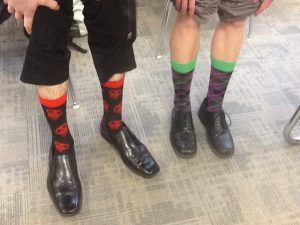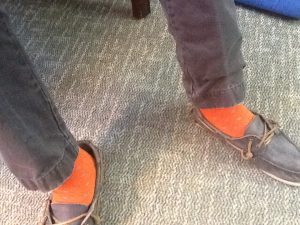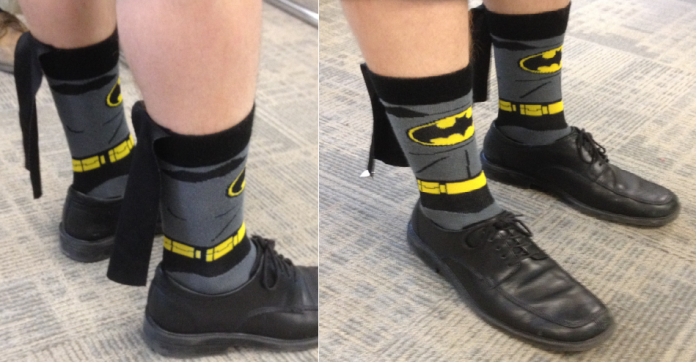One looks down the halls at Jesuit and sees endless columns of legs shuffling along the floor. The familiar thud of the Sperry soles sounds down the hall. Peer above the shoes, and it’s easy to miss one of the subtle aspects of the uniform, yet one of the most distinctive. Some athletes wear their “Nike elites” with their characteristic stripe down the back, while other students wear their simple black or white socks. There are also those who wear no socks, which fashion wise, I’m okay with. (Not that I condone this… School administration.)
 The origin of socks comes not from a fashion standpoint, but rather from protective purposes. They were first worn in ancient times and were made out of animal skin in order to protect feet from the ground; these were essentially the original shoes. Later on, socks were a mark of wealth, worn underneath garters, but they were still not decorative at this point. Only in the 15th to 16th centuries were socks finally used for decorative purposes and began to sport various colors. At this time, they were specifically connected to the pants that one wore, essentially acting as stockings. As men’s pants grew longer, the socks became shorter in length and are now what we know them to be today.
The origin of socks comes not from a fashion standpoint, but rather from protective purposes. They were first worn in ancient times and were made out of animal skin in order to protect feet from the ground; these were essentially the original shoes. Later on, socks were a mark of wealth, worn underneath garters, but they were still not decorative at this point. Only in the 15th to 16th centuries were socks finally used for decorative purposes and began to sport various colors. At this time, they were specifically connected to the pants that one wore, essentially acting as stockings. As men’s pants grew longer, the socks became shorter in length and are now what we know them to be today.
When it comes to selecting a pair, it is not necessary to match the socks with the rest of the outfit. For me, depending on the situation, the socks should be vastly different from the rest of the outfit. Rob Brinkley, Editor of FD Luxe, says not to “key your sock color too closely to your pant or shoe color: something more ‘off’ is always more interesting.”
AP U.S. history teacher Mark Batik offers a different opinion, saying that one should pick a “color that is part of [their] shirt or tie.”
I also like to pick out socks depending on the formality of an event. If it’s a black tie event, just go with black silk socks. For business attire, you can wear a slightly more unusual sock, perhaps adding a pattern and a touch of color. In my opinion, this color by no means needs to match any aspect of the outfit. Brinkley would suggest that one should “lighten up the socks a bit,” however “don’t go too colorful or zany.” He believes that it is important to have interesting socks, because “it says you’re a guy who pays attention to details,” which “is a really, really good message to send, in business or in life.”
When picking out socks, length and material factor in the choice. Regarding length, they should at least cover the ankle enough so that your leg cannot be seen when you sit down. There isn’t too much flexibility there. However, there are many different materials to be picked from. The major materials are silk, wool, cotton, and nylon. Brinkley says “silk and nylon are better than cotton or wool,” because “they wick moisture away from your feet more effectively.” Of course, the silk and nylon will always be more expensive than the cotton socks. From a comfort perspective though, the silk socks are definitely worth the extra price. Another material worth considering would be cashmere, as suggested by Batik. However, cashmere socks can be expensive as well. Though some might be expensive, socks are what you stand on all day, so a good pair can vastly improve your daily comfort.
seen when you sit down. There isn’t too much flexibility there. However, there are many different materials to be picked from. The major materials are silk, wool, cotton, and nylon. Brinkley says “silk and nylon are better than cotton or wool,” because “they wick moisture away from your feet more effectively.” Of course, the silk and nylon will always be more expensive than the cotton socks. From a comfort perspective though, the silk socks are definitely worth the extra price. Another material worth considering would be cashmere, as suggested by Batik. However, cashmere socks can be expensive as well. Though some might be expensive, socks are what you stand on all day, so a good pair can vastly improve your daily comfort.
Regarding where to pick out a pair of socks, my personal favorites include J. Crew, Banana Republic, and many online retailers such as the Tie Bar. If you’re looking for cold weather socks that have some style, certain brands of ski socks can fit the bill. For nicer socks, Brinkley recommends “Pockets, Ken’s Man’s Shop, Cullwell & Son, [and] Q Custom Clothier.”
In reality, it’s pretty difficult to go wrong with a pair of socks, as long as they don’t have holes in them. I know you Jesuit Students. For me, having a great pair of socks just means that, rather than haphazardly throwing clothes on, because you overslept your alarm, you woke up and thought about every aspect of your outfit before coming to school: you’re a man of minutia.






